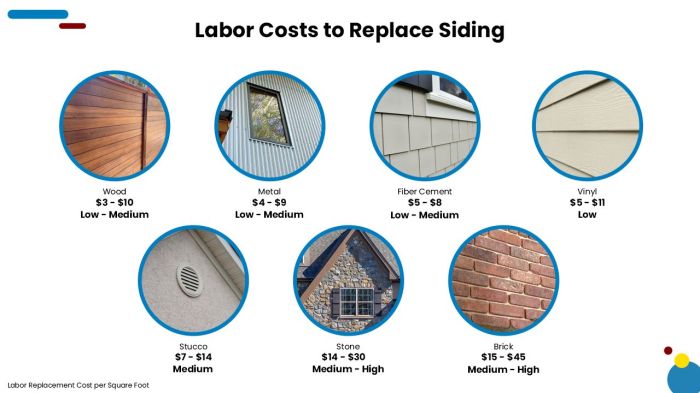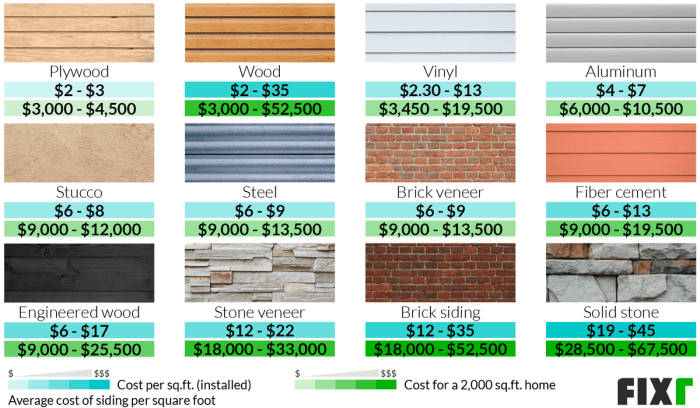Cost of Siding and Installation: A Comprehensive Guide
Cost of siding and installation sets the stage for this enthralling narrative, offering readers a glimpse into a story that is rich in detail and brimming with originality from the outset.
Exploring the various types of siding materials, factors influencing costs, the installation process breakdown, and cost-saving tips provides a well-rounded view on this essential aspect of home improvement.
Types of Siding Materials

When it comes to choosing siding materials for your home, there are several options available, each with its own set of pros and cons. Let’s take a closer look at some of the most commonly used siding materials and compare their costs and installation requirements.
Vinyl Siding
Vinyl siding is a popular choice for homeowners due to its affordability and low maintenance requirements. It is available in a wide range of colors and styles, making it versatile for different design preferences. The cost of vinyl siding is relatively low compared to other materials, making it a budget-friendly option.
However, it may not be as durable as some other materials and can crack or fade over time.
Wood Siding
Wood siding has a natural and timeless look that many homeowners find appealing. While it can be more expensive than vinyl, wood siding is durable and can last for decades if properly maintained. The cost of wood siding can vary depending on the type of wood used, with cedar and redwood being popular choices.
However, wood siding requires regular maintenance, such as painting or staining, to prevent rot and insect damage.
Fiber Cement Siding
Fiber cement siding is a durable and low-maintenance option that mimics the look of wood without the high cost. It is resistant to rot, fire, and insects, making it a popular choice for many homeowners. While the initial cost of fiber cement siding may be higher than vinyl, it can save money in the long run due to its longevity and minimal maintenance requirements.
Metal Siding
Metal siding, such as aluminum or steel, is known for its strength and durability. It is resistant to fire, insects, and rot, making it a low-maintenance option for homeowners. Metal siding is available in a variety of finishes and colors, allowing for customization to suit different architectural styles.
While the initial cost of metal siding may be higher than vinyl or wood, it can last for many years with minimal upkeep.
Factors Influencing Cost

The cost of siding and installation can vary based on several key factors that influence the overall price. Factors such as the size of the house, labor costs, location, and additional features all play a significant role in determining the total cost.
Size of the House
The size of the house is a major factor that impacts the cost of siding and installation. Larger homes require more materials and labor to complete the job, which can result in higher overall costs. The square footage of the house directly correlates to the amount of siding needed, affecting the total price of the project.
Labor Costs
Labor costs are another crucial factor in determining the cost of siding and installation. The expertise and experience of the laborers involved, as well as the time required to complete the project, can significantly influence the final price. Skilled labor comes at a higher cost, but ensures quality workmanship that can affect the longevity and appearance of the siding.
Location and Additional Features
The location of the house can also impact the cost of siding and installation. Factors such as accessibility, local labor rates, and building codes can all play a role in determining the overall price. Additionally, the inclusion of extra features like trim work, insulation, or unique siding materials can add to the total cost of the project.
These additional elements contribute to the overall aesthetic and functionality of the siding but come with an extra cost.
Cost of Installation
When it comes to the cost of siding installation, there are several factors that can influence the overall price. Let’s break down the typical cost breakdown for siding installation and explore how complexity, preparation work, and finishing details can impact the installation cost.
Typical Cost Breakdown
- Materials: The cost of the siding material itself is a significant portion of the overall installation cost. This can vary depending on the type of siding chosen.
- Labor: Labor costs for installation can also vary based on the complexity of the project and the skill level of the workers.
- Additional Supplies: In addition to the siding material, other supplies such as nails, caulking, and insulation may be needed, adding to the overall cost.
Examples of Installation Costs per Square Foot
- Vinyl Siding: On average, vinyl siding installation can cost between $3 to $7 per square foot.
- Fiber Cement Siding: Fiber cement siding installation typically ranges from $5 to $12 per square foot.
- Wood Siding: Wood siding installation costs can vary widely, from $6 to $15 per square foot.
Factors Influencing Installation Cost
- Complexity: The complexity of the project, such as multiple stories, intricate designs, or unique architectural features, can increase the installation cost.
- Preparation Work: Any necessary repairs, removal of old siding, or additional structural work needed before installation can impact the overall cost.
- Finishing Details: Custom finishes, trim work, and special features can add to the installation cost, as they require additional time and materials.
Cost-Saving Tips
When it comes to reducing the cost of siding and installation, there are several strategies you can consider. Whether you are looking to tackle the project yourself or negotiate prices with contractors, these tips can help you save money while still achieving the desired results.
Consider DIY Options
If you have some experience with home improvement projects and are willing to put in the time and effort, opting for a do-it-yourself approach can lead to significant cost savings. By taking on the installation of the siding yourself, you can eliminate labor costs and only need to cover the materials.
Negotiate Prices
When hiring professionals for the siding installation, don’t be afraid to negotiate prices with contractors and suppliers. Obtain multiple quotes and compare them to ensure you are getting a fair deal. You can also try to negotiate for discounts or ask if there are any promotions or deals available that can help lower the overall cost.
Closing Notes
In summary, understanding the cost of siding and installation is crucial for homeowners looking to renovate or build their homes. By considering the different materials, factors affecting costs, and tips to save money, individuals can make informed decisions that align with their budget and preferences.
FAQ Compilation
What are the most common types of siding materials used?
Vinyl, wood, fiber cement, and metal are commonly used for siding due to their durability and aesthetics.
How does the size of the house impact the cost of siding and installation?
Larger houses generally require more materials and labor, resulting in higher overall costs for siding and installation.
Are there any DIY options available to reduce costs?
Yes, DIY siding installation can lead to savings compared to hiring professionals, but it requires skill and knowledge to ensure a successful outcome.
What factors can help in negotiating prices with contractors and suppliers?
Being informed about market prices, comparing quotes from multiple sources, and demonstrating flexibility in project timelines can aid in negotiating lower costs.




